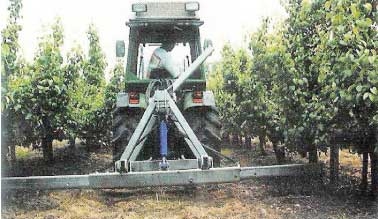When root pruning, the roots of fruit trees are cut by dragging a cutting blade down the row near the trunks.
Root pruning is done with a sharpened blade mounted on a tool bar such that it extends out beyond the rear tires of the tractor. Tractors in the 40 to 50 horsepower class have proven satisfactory.
The blade cuts the roots that grow into the rows and reduces root volume, thereby reducing the root/shoot ratio.
First, the supply of water, mineral nutrients and hormones from the roots to the tops decreases as a result of the smaller root system. This causes a decrease in shoot growth.
But then a larger percentage of assimilates is transported to the roots, which lead to the development of new roots. These new roots stimulate the supply of growth-promoting hormones to the tops (more shoot growth).
Compensating root growth then takes place in order to restore the normal root/shoot ratio. Root pruning for growth restriction will have to be done regularly (annually)—that is, before the root/shoot ratio has been restored.
Opinions on the effectiveness and risks of root pruning are still divided, especially in countries that have long hot summers.
It is claimed that correct root pruning:
- Reduces vegetative growth and promotes development of flower buds
- Can have a negative effect on fruit set and fruit size by slowing down cell division
- Reduces pre-harvest drop
- Increases pre-harvest drop
- Lessens biennial bearing
- Gets better return bloom
- Gets better skin colour
- Makes fruit firmer at harvest
- Produces higher fruit sugar content
- Lowers fruit magnesium and increases calcium levels.
However, you can expect a wide variation in response to root pruning. Different crops react differently to root pruning. This is due to method used, growing conditions, tree vigour, climatic conditions and varietal response.
Best time to prune roots
The best time to prune roots is from full bloom until two weeks later. Prune roots only when flowering is sparse, or to break a biennial pattern (in the off year).
If flowering is not sparse, but the trees still have had too much vigour, prune roots in late November or early December—after the fruit has set and cell division has ended. Do not prune roots when there has been a good fruit set for fear of affecting fruit size.
Here are some problems you may run into when you prune roots:
- Trees that have been root pruned are easily stressed and need careful watering and feeding until their roots have re-grown. A heat wave after root pruning can be disastrous.
- Trees may die if too many roots are pruned particularly during a warm dry year. If not enough roots are pruned, excessive root development and shoot growth will be the result.
Continued next issue
For more information & photos see Tree Fruit September 2013






















